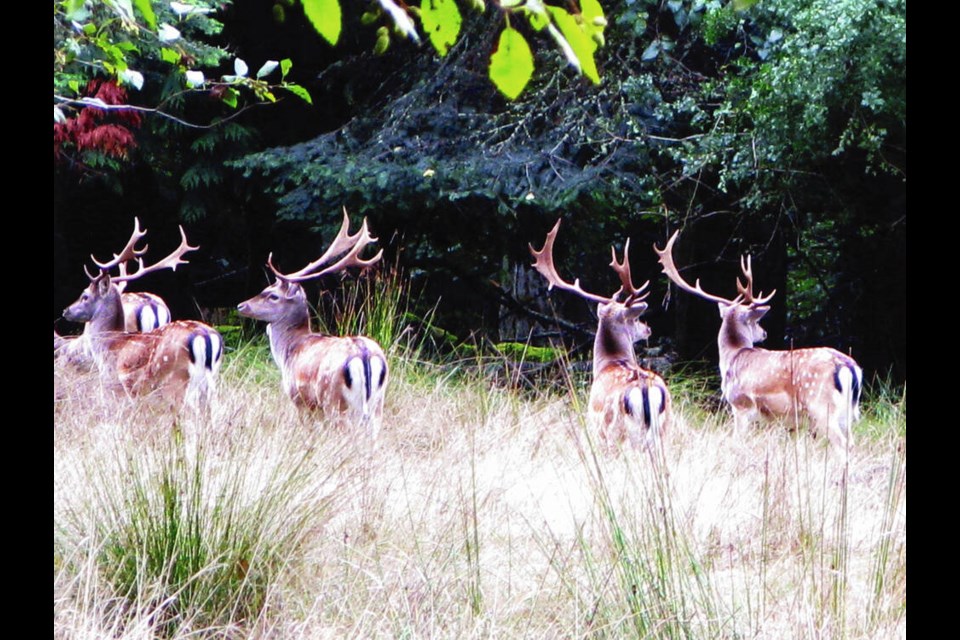The killing of deer on Sidney Island will begin on Dec. 1, when sharpshooters will start picking the animals off from a helicopter, by land and from boats.
The cull, planned by Parks Canada and expected to last 10 days, is intended to eliminate European fallow deer — an invasive species — from the island, but will also see native black-tailed deer killed.
Property owners on the island — located east of Sidney and just four kilometres from Island View Beach in Saanich — confirmed the kill window after being informed this week by Parks Canada.
Parks Canada controls about 440 hectares on the north end of Sidney Island, including Sidney Spit, as part of Gulf Islands National Park Reserve. But the majority of the island is privately owned in strata lots and a common area. Earlier this year, residents approved Parks Canada’s plan for deer eradication in a narrow 52% vote.
The plan to use private contractors to kill the fallow deer and restore native plants on the nine-square-kilometre island at a cost of $5.9 million has divided the island.
Those in favour want the fallow deer gone while those against favour continued private hunting that they say has winnowed the population of fallow deer to fewer than 200 animals.
Few of the 111 private property owners are expected to be on Sidney Island during the aerial and land hunt, said resident Paul Lalonde, who opposes the cull and had written to the RCMP’s chief firearms officer asking that the permits not be issued.
Freedom of Information documents acquired by Lalonde show that Coastal Conservation and its contractor, White Buffalo, will use restricted semi-automatic assault-style rifles to dispatch the deer.
And they will be equipped with suppressors, or silencers, using .223-calibre ammunition with extended magazines holding up to 30 rounds, he said.
Parks Canada said the temporary permits to use restricted semi-automatic weapons and light utility helicopters for shooting the deer from the air have been approved by the RCMP and Transport Canada, respectively.
Lalonde said the shooters won’t be using scopes on the rifles in helicopters because of vibrations in the aircraft. “The idea is to pepper a lot of shots in a hurry in [a deer’s] direction,” said Lalonde.
He said any hunter following regulations does not shoot at moving animals because it’s nearly impossible to make a clean kill.
He said the helicopter shooters will mark their kills using “GPS pins” and ground crews are expected to move in later and collect the dead deer. But Lalonde said without scopes, he expects many of the animals will likely be wounded and suffer, going into undergrowth where they may be difficult to find.
The FOI on the hunt also included a list of Parks Canada watercraft available to staff and the contractors for “eradication operations, including actively hunting or herding wildlife.”
That doesn’t sit well with some of the residents, said Lalonde, who said all of the homes on the island ring the south end.
The contractors will be allowed to shoot deer as close as 25 metres from the island’s homes, said Lalonde, who is concerned about shots from the water that could come too close to properties.
“There are few shore-boat positions that would have lines of fire to deer that do not intersect private lots,” Lalonde said in his letter to the RCMP’s chief firearms officer. “Likewise, heavy semi-automatic fire from helicopters, suppressed or not, is not appropriate in a year-round populated island.”
Lalonde called the overall plan an “inherently risky activity … There is good reason that we restrict these weapons, and the Sidney Island eradication does not rise to the level of immediate ecological need that would justify this permit.”
Parks Canada has done no formal count of the population of fallow deer on Sidney Island, giving only a broad estimate of between 300 and 900 animals.
Kate Humble, superintendent of Gulf Islands National Park Reserve, told the Times Colonist in August that while the number of fallow deer is currently relatively low, the population has gone through cycles of rebounding to unsustainable levels after dropping over the past few decades.
“Every time there’s been a significant reduction, it has come back,” she said. “And so, long-term sustained recovery of the ecosystem is simply not feasible unless the population is entirely removed.”
Since the early 1980s, 15,000 fallow deer have been removed from the island through hunting and culling, and despite those efforts to reduce numbers, the forest understory has not sufficiently regenerated, Humble said.
But Lalonde disagrees.
He said a UBC study in 2019 indicated the understory of plants and saplings had improved by 30% with continued hunting, and it continues to improve today.
“I’m out in the woods there a lot and seeing lots of recovery,” he said. “We have aspen, yew trees as tall as my elbow and long-leaf pines coming up. [Parks Canada] isn’t doing the work to see [the recovery].”
During a shortened hunting season this year from Oct. 15 to Nov. 15, Lalonde said private hunters took 50 fallow deer using just 70 bullets. Among the kills were 15 fallow deer fawns, which Lalonde said is much lower than usual and indicative of the declining population.
He said the only recourse to stop the planned eradication is through a court injunction. However, he said the homeowners who are against the kill don’t have the $50,000 to $75,000 to put up the fight. “Many of us are just tapped out,” he said.
Parks Canada said in a statement late Thursday that the primary killing methods for the first phase of the cull include ground hunting and aerial shooting. “We are not currently expecting to dispatch from boats during Phase 1 unless the need arises.”



